Introduction

It is a bit odd that the manufacturers of E-mount lenses seemingly abandoned the 28mm focal length, especially when it comes to AF lenses. The only ones available for the FE system are the mediocre Sony FE 28mm 2.0 and the huge designed-for-DSLR Sigma 28mm 1.4 Art – both released in the early days of the FE system and nothing came since. Until now, as Viltrox is offering an alternative with this 28mm 1.8 AF lens. The recently reviewed Viltrox 16mm 1.8 AF proved to be an astonishingly good lens, will this 28mm lens be similarly good? Let’s find out.
Sample Images





Most of the sample images in this review can be found in full resolution here.
Contents
Specifications
The Viltrox 28mm 1.8 AF FE has the following specifications:
-
- Diameter: 70 mm
- Field of view: 74.6° (diagonally)
- Length: 84 mm
- Weight: 366g (without hood and caps)
- Filter Diameter: 55 mm
- Number of Aperture Blades: 9 (rounded)
- Elements/Groups: 11/9


- Close Focusing Distance: 0.37 m
- Maximum Magnification: 1:10 (measured)
- Mount: Sony E
buy from manufacturer’s shop (use the code “PRnet” for 8% discount) | B&H | ebay.com (affiliate links) for $379
Disclosure
The Viltrox 28mm 1.8 AF FE was kindly provided free of charge by Viltrox for reviewing purpose for a few weeks.
Handling/Build Quality

After having used the Viltrox 16mm 1.8 AF this 28mm 1.8 is unfortunately a bit of a disappointment in this category.
While the lens features an aperture ring it is a clickless design, except for one click stop for the “A”(utomatic) setting. When set to “A” you can let the camera choose the aperture value or use the camera dial to change the aperture value instead of using the aperture ring.
The focus ring has okay damping and a linear coupling. No matter how fast you turn the focus ring it always takes 360° from the minimum focus distance (0.37 m) to infinity.
When you turn your camera off the lens will remember the last focus position and will still be there when you turn the camera on again.
Now sadly that was already it in terms of controls. I would have at least liked an AF/MF switch.
While there is a USB-C socket for firmware updates to be found at the bayonet this lens also does not feature a rubber gasket.
The outer casing seems to be made from a high quality polycarbonate and all markings on the lens barrel are engraved and filled with paint. The markings on the front retention ring seem to be only printed though.

Sadly also the hood is of lower quality compared to that of the 16mm 1.8. It is made from different (seemingly cheaper) materials than the actual casing and it needs a lot of force to attach and detach.

The Viltrox 28mm 1.8 AF is noticeably bigger than the Sony FE 28mm 2.0 and closer in size to the much faster (but also manual focus) Laowa 28mm 1.2 Argus.
AF performance
I am not shooting sports or fast moving animals/humans so if you want to know if the lens is fast enough for this or how it compares to other lenses in this segment you may have to look for a different review with a more detailed assessment of this aspect.
In everyday use I found the AF to be very fast, perfectly usable and also silent..
Vignetting

| f/1.8 | 3.2 EV |
| f/2.0 | 3.0 EV |
| f/2.8 | 2.2 EV |
| f/4.0 | 1.8 EV |
| f/5.6 - f/16 | 1.7 EV |
This is still a compact lens and the lens elements also look rather small so I expected high vignetting figures and this is exactly what we got. At its maximum aperture the Viltrox shows noticeably higher vignetting than the Laowa 28mm 1.2 and the 7Artisans 28mm 1.4 at their (faster) maximum apertures. At shared apertures there is almost 1 EV difference.
The Sony FE 28mm 2.0 shows a similar performance at f/2.0 though.
Stopped down to f/8.0 to f/11 they all perform similar in this category.
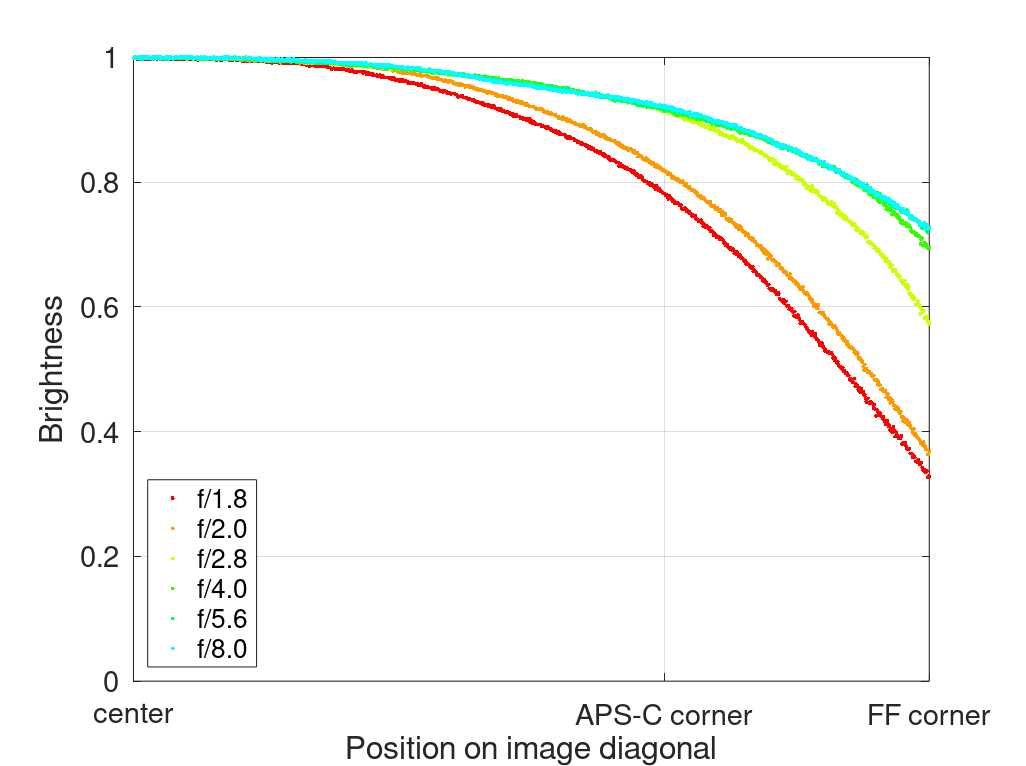
It is recommended to have a look at this article first to get an idea how this brightness graph works.
Sharpness
Focus Shift
With some lenses the point of optimal focus shifts on stopping down, this is not the case here.
infinity (42mp Sony A7rII)


The Viltrox 28mm 1.8’s MTF graphs may not look as good as those of the Viltrox 16mm 1.8, but still good.
The center already looks really good from f/1.8. No apparent softness or color aberrations. The midzone shows a tiny dip in resolution on the 42mp sensor that might not even be visible in a 24mp sensor and already looks really good from f/2.8.
At wider apertures the corners seem to suffer from astigmatism and maybe also coma a bit, but they improve steadily on stopping down and peak performance is reached around f/5.6.
How does this performance compare to the other 28mm E-mount lenses? The Laowa 28mm 1.2 starts at f/1.2 and when stopped down to f/2.0 it shows no midzone dip and impressive corner performance. The 7Artisans 28mm 1.4 actually performs very similar at shared apertures. The Sony FE 28mm 2.0 also performs similar, but its corner performance looks a bit worse to me.
portrait distance (0.9 m)

I refocused for every shot and aperture to get the best possible result at different locations in the frame (center, inner midframe and outer midframe).
The circle of the dollar bill is more or less the size of a human eye.
f/1.8 <—> f/2.8
Very good performance already at f/1.8, no complaints!
close 0.37 m, 1:10 (42mp Sony A7rII)
A minimum focus distance of 0.37 m sits in the middle compared to the competitors (0.5 m for the Laowa 28mm 1.2, 0.7 m for the 7Artisans 28mm 1.4 and 0.28 m for the Sony FE 28mm 2.0 and Sigma 28mm 1.4).
The image is a bit soft at f/1.8 but clears up nicely already on stopping down to f/2.8. Typical behaviour for a lens like this, no complaints again.
Flare resistance
As always evaluating flare is a complex matter since you can get any lens to look bad if you push it hard enough and a slight change of scenario can affect results a lot.
With the sun inside the frame often small purple ghosts appear, with the sun just outside the frame veiling flare can be an issue. In some cases it was possible to get rid of these artefacts by shading the lens:
With strong point light sources in the dark also some artefacts may appear:

All in all this is a respectable performance, but I think flare resistance is a category where the Sony FE 28mm 2.0 performs a bit better.
Coma
After the Viltrox 16mm 1.8 AF this is only the second Viltrox lens I am reviewing but it seems to me correcting coma properly might be pretty high on their list of design criteria.
At f/1.8 some coma is visible, by f/2.8 it is almost completely gone.
The Laowa 28mm 1.2 performs similar at shared apertures, the 7Artisans 28mm 1.4 even a bit better. I haven’t used the Sony FE 28mm 2.0 personally, but from other reviews it looks similar at f/2.0 and worse at f/2.8.
Distortion
The Viltrox 28mm 1.8 AF shows a low amount of wavy pincushion distortion. For most Viltrox lenses a Lightroom profile is available, so I expect this lens to be included in one of the future updates as well. Viltrox may also beat them by offering a profile for download on their homepage like they do for many of their other lenses already. Until then you can use the profile for the Viltrox 24mm 1.8 FE instead as I did here as it does a surprisingly good job..
Bokeh

A fast 28mm is a lens I would be using for environmental portraits, so the bokeh quality would be of high interest to me.



A minimum focus distance of 0.37 m is not best in class, but it still allows for close ups with a lot of background blur.

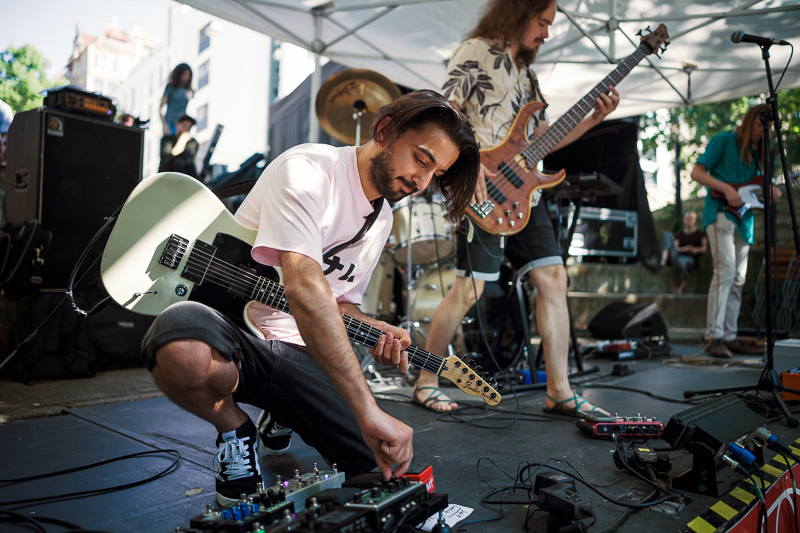

What I really liked about this lens is the bokeh rendering at longer focus distances, even with complex backgrounds. There is hardly any outlining and the out of focus areas are never distracting.



In this category I think the Viltrox is a better choice than the Sony FE 28mm 2.0.
Sunstars
Regular readers already know that an even number of aperture blades leads to distinct sunstars whereas this Viltrox 28mm 1.8 AF is using 9 aperture blades – just as the Viltrox 16mm 1.8 AF..
The alignment of the blades is pretty good though and we see nice sunstars from f/5.6 to f/16, similar to those we have seen from the Sony FE 20mm 1.8G.
We haven’t exactly been blessed with 28mm lenses with nice sunstars. The Sony FE 28mm 2.0 is not doing a good job and neither are the 7Artisans 28mm 1.4 nor the Laowa 28mm 1.2. The Voigtländer 28mm 2.0 Ultron does, but it has some other issues on E-mount cameras, so this Viltrox is definitely one of the better options here.
If you want to know more about sunstars have a look at this article.
Chromatic aberration
lateral
Lateral CA are so well corrected, I cannot show you any here.
longitudinal
The Viltrox 28mm 1.8 AF shows an average amount of longitudinal CA at f/1.8. Stopped down to f/2.8 they are almost completely gone.
Conclusion
good
|
average
|
not good
|
My contact at Viltrox was actually a bit reluctant when I asked for a review sample of this 28mm lens. I was told it wasn’t as good as the 16mm 1.8 and also optimized for video, not so much still photography. After having used this lens I think Viltrox could have been a bit more content with this lens though.
This is a very solid lens without any really outstanding flaws. What I like most about it, is its bokeh rendering, as even at longer focus distances – where some of the 28mm lenses struggle with field curvature (looking at you, Laowa 28mm 1.2) – this Viltrox lens always creates appealing and undistracting out of focus areas.
Currently this lens is only available for E-mount and here we have to compare it to the Sony FE 28mm 2.0. I actually don’t see a clear winner. I prefer the bokeh, CA correction and sunstars of the Viltrox, but the flare resistance as well as size and weight of the Sony lens. And in some places the first party lens being cheaper than the third party option is also a bit of an oddity.
I really wish this 28mm Viltrox lens had the controls of the 16mm 1.8 to also match the Sony GM, G and Sigma Art DG DN lenses. In that case a slightly higher price could be more easily justified.
If you don’t care as much about an AF/MF switch or a clicked aperture ring like I do, and you simply didn’t like the Sony 28mm 2.0 because of its strong CAs, whacky sunstars or very high (but easy to fix) distortion this Viltrox lens might still be what you have been waiting for.
buy from manufacturer’s shop (use the code “PRnet” for 8% discount) | B&H | ebay.com (affiliate links) for $379
Alternatives
I will only talk about the obvious alternatives here, meaning other modern 28mm primes available for E-mount. There are of course many zooms available covering 28mm as well, you can find those discussed in our FE Guide.
AF
Sony FE 28mm 2.0:
The most obvious competitor is one of Sony’s earlier fullframe E-mount lenses. Unfortunately it does neither offer the image nor the build quality of Sony’s latest G lenses (see Sony FE 20mm 1.8 G for comparison), but it is also significantly cheaper.
A solid but not outstanding lens, I talked about the differences in the parargaphs above which should help you to make a decision if deciding between these two lenses.
buy from Amazon.com | Amazon.de | ebay.com | ebay.de | B&H for $448 (affiliate links)
Sigma Art 28mm 1.4:
This might be Sigma’s best balanced late f/1.4 DSLR prime, but when used on a mirrorless camera it is still a huge and much heavier lens compared to any other 28mm lens specifically designed for mirrorless cameras. It also has some other issues like mediocre flare resistance and high vignetting. Still, if you want a 28mm f/1.4 lens with good AF this is currently your only choice.
buy from Amazon.com | Amazon.de | B&H | ebay.com for $999 (affiliate links)
MF
Laowa 28mm 1.2 Argus:
This is the world’s fastest 28mm lens with surprisingly good sharpness already at f/1.2 and amazing bokeh at close to mid distances. Downsides are a minimum focus distance of 0.5 m, lack of EXIF data and not so great bokeh at longer focus distances.
buy from the manufacturer’s homepage | B&H (affiliate links) for $599
7Artisans 28mm 1.4 FE+:
This was the first 7Artisans lens and it is still a really compelling option. It is slightly faster, has a worse minimum focus distance (0.7 m) and is smaller but heavier. What should guide your decision is whether you want an AF or an MF lens.
buy from manufacturer’s shop, B&H, amazon.com/amazon.de ebay.com/ebay.de for about $436 (affiliate links)
Sample Images













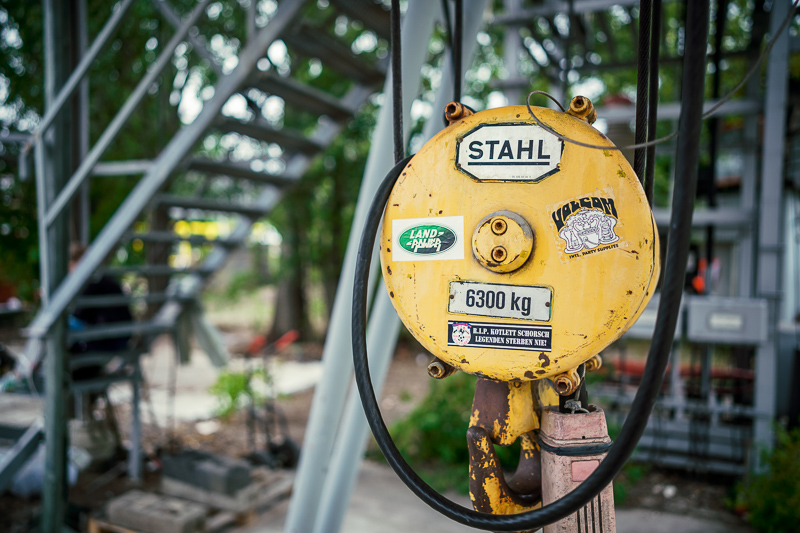
Most of the sample images in this review can be found in full resolution here.
Further Reading
- All Lens Reviews
- Lens aberrations explained
- Technical Knowledge
- Guide: 20-28mm lenses for Sony FE
- Follow us on Discord
Support Us
Did you find this article useful or just liked reading it? Treat us to a coffee!
![]()
![]()
![]() via Paypal
via Paypal
This site contains affiliate links. If you make a purchase using any of the links marked as affiliate links, I may receive a small commission at no additional cost to you. This helps support the creation of future content.
Latest posts by BastianK (see all)
- 2025 – Year in Review - December 23, 2025
- Review: Sony FE 70-200mm 4.0 G Macro OSS II - December 20, 2025
- Review: Viltrox AF 35mm 1.2 FE LAB - December 17, 2025


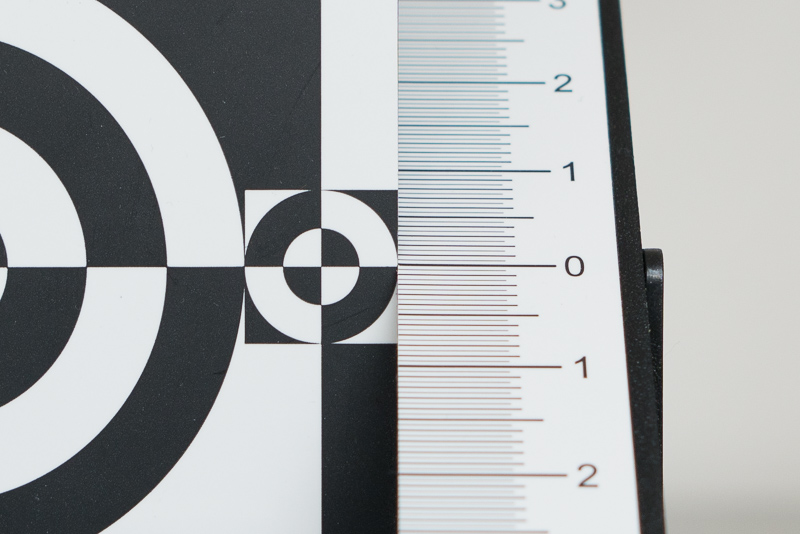




















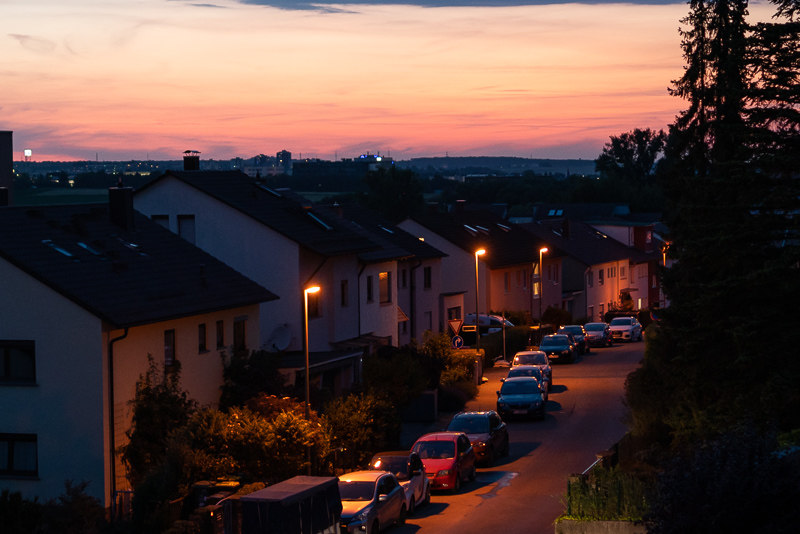






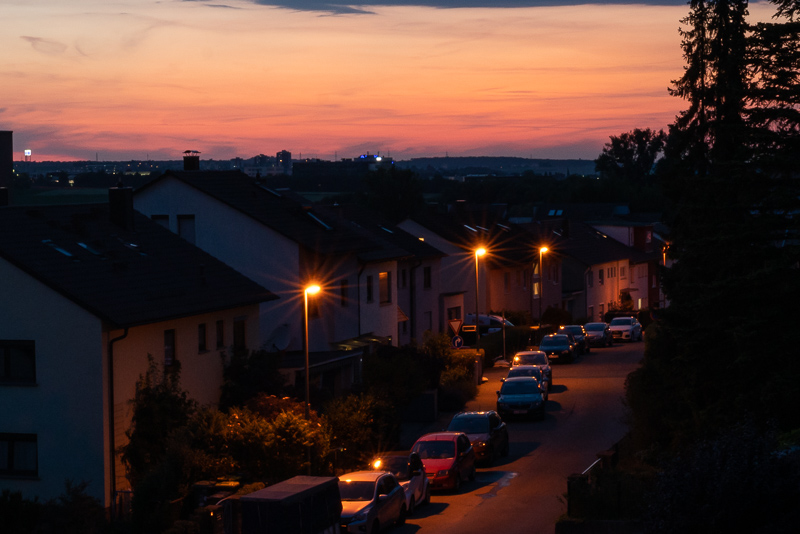



Danke Bastian!
Ein vorzügliches Review.
Das Viltrox ist nun für mich die bessere Wahl gegenüber dem Sony!
Bokeh ist mir wichtig und auch Comakorrektur.
Beste Grüße Ernst-Dieter
At this point, I’m starting to think that there must be some technical difficulty in creating a good, quite fast 28mm lens for either a full frame digital sensor/Sony E mount (like the opposite of the 135mm focal length, where it seems very easy to make a well-correctly lens – see Sony, Samyang, Sigma, etc.).
As this is my favourite walk-around focal length, I’ve had to resort to adapting Leica and Minolta manual focus lenses to find a compact and decent optical package. Do Sony not care about this focal length because of the proliferation of smart phones with a 28mm main camera and therefore a small potential market?
I think we will get there some day.
I still remember when all the 35mm options were extremely bad. Wasn’t that long ago.
Are there any good compact 35mm options now though? I tried the samyang 1.8… But after using it for a few days I switched back to my APS-C viltrox 23mm because IQ is basically the same and viltrox at 1.4 is actually 2.2x brighter than samyang at 1.8 neglecting any full frame benefits
If it has to AF the best option might be the Sigma 35mm 2.0 DG DN C.
Not sure how moch you gain here over the Viltrox though.
Smartphone cameras may have been around 28-30mm a few years ago but they’re actually trending wider these days, even on the iPhone & Pixel (some of the last holdouts) the main module is now closer to 23-25mm. Cheaper FE zooms (Tamron’s basically) do start at 28mm tho, and 20/24mm have seen a big rise in popularity thanks in part to video…
It’s not just Sony/E-mount tho, there’s a cheapo 14/2.5 and the PL15/1.7 for M4/3, and Nikon has that cheap 28/2.8, but most other mirrorless mounts lack a lot of 28mm options as well (outside of Fuji and Leica M). I think when more holes are filled in those lineups we might see more 28mm options, hopefully, I think too many default to 35mm these days for lack of options.
Thank you for the amazing review! Now I’m very curious to see how good is it compared to the new ms optics 28mm f1.7, look forward to your review of this lens 😀 😄
I canceled my pre-order on the MS-Optics lens. Mkdirect added some surcharges which in combination with our huge import taxes in Germany lead to that decision.
Tariffs have been reduced to max 7%.
But sales taxes, while varying in Europe amount to another 20%.
Ich bin immer noch an knüseln, Sony 2,0/28mm oder Viltrox 1,8/28mm.
Das DxO Profil für das Sony ist schon ein dicker Pluspunkt!
Do you anticipate voigtlander making a 28mm lens for emount? I wonder if they will add it to their apo-lanthar series
I don’t have that great influence there 🙂
Maybe it’s not all that bad of a thing that voigtlander isn’t very receptive to immediate demands as that might “poison the well” so to speak. They retain a character and quality that is largely unparalleled and if they listened too much to immediate demands from online reviewers and consumers they would have to compromise on their design philosophy in order to deliver a product that would satisfy said demands. Or maybe I’m getting too philosophical 🧐
If only, I’d jump on a 28/2 APO-Lanthar that’s smaller than my 35GM… Right now I’d just crop into a 24mm (or shoot it in 4:3 AR, close enough), but 28mm would be a nice sweet spot for a well corrected manual lens in my kit.
Given the popularity and numbers of 35mm and 24mm lenses I think it’s understandable why we haven’t seen many 28’s, but I think they do have a niche, and I like them myself. This Viltrox seems quite intriguing even if I think it’s a little bit bigger than I’d prefer…!
viltrox seems to be absolutely knocking it out of the park for their price point. I’ve got a 23 1.4 for Fuji and it’s amazing. I’m hoping they continue to put out amazing full frame lenses for Sony I may be adding a few to my collection.
I’d been waiting to buy a 28mm for a while. Bokeh, rendering and sharpness wide open are important to me so I bought the Viltrox 28mm not the Sony. I’m very happy, the Viltrox 28mm produces really great images and is sharp on my A7R4. My copy has good veiling flare resistance against the sun so I wouldn’t put flare as a negative. My only negative is the clickless aperture ring.
I’m usually in agreement with your reviews but I thought you were a bit negative here and didn’t appreciate how good the images from this lens are.
I would buy this lens if it had AF/MF switch. Why Viltrox skipped this…
28mm is probably my favorite focal length and the Sigma F1.4 was my goto whenever I just wanted to take photos at parties that happened late in the day / evening – kept the ISO just bearable enough to produce salvageable images for smartphone viewing (iso 10.000) even in the disco (I abhor flash in these situations – the entire point of a disco/club besides the music is the mood produced by the lighting) and could still produce beautiful separation for environmental portraits.
Wish viltrox had gone for a pro version and a brighter aperture here, there’s currently no professional grade native mirrorless 28mm on the market and I feel that perhaps lensmakers are underestimating the potential demand for it.
typical example of modern lens design.
Sharpness – Yes
Micro contrast – No !
You might as well use the lowly 28/2.0FE
I would like to add my support to the many voices here for a high quality 28mm lens from Sony. Just in case Sony are reading these comments. I have a nice collection of Sony GM glass, yet my most used FL is 28mm (by far) and I have to make do with a relatively cheap 28mm f2 that is “okay” but certainly not in the league of excellence.
I think Leica and Ricoh with their Q and GR series have proven beyond doubt that there is a market for 28mm. Please Sony – make a 28/1.4 GM, or even better for me, a lighter weight 28/1.8 G, with a clickable aperture ring (or selectable on-off click stops). If it were small enough it would be a dream general carry and street-shooter’s lens on an A7c series camera.
working photographer for 50 years….a good 28mm was a standard street, travel assignment lens for many photographers….Sony needs to address this…many of us have invested in their gear….waiting for a good 28mm….I don’t think they realize how popular a lens it would be…perhaps they don’t have any photographers in their sales division
Great review, thanks for sharing.
I think that the coma test at f/1.8 and f/2.0 are actually taken at the same aperture (but different exposures). The sun stars are *identical* whereas there is a large difference between f/2.0 and f/2.8.
No they are not, the difference between f/1.8 and f/2.0 is simply minimal (third of a stop) whereas that between f/2.0 and f/2.8 is a full stop.
I havent seen a comparison of this lens and the Q3 as yet and also havent seen a Q3 image that convinces me that it renders as nice as this Viltrox. Would love to see a direct comparison.